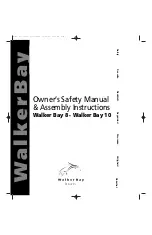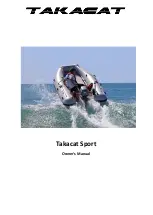
1-16
130 Super Sport
Section 1• Safety
R
To avoid boating in unsafe areas where there are
underwater obstructions, shallow water, unnavigable
conditions such as dangerous currents, and others,
you must chart a course. this means having and
u s i n g N a t i o n a l O c e a n i c a n d A t m o sp h e r i c
Administration (NOAA) charts for coastal waters,
observing and understanding all navigational aids,
using the knowledge and guidence of experienced
boaters, and being aware of the tides and times
where appropriate. If you are boating in an area you
are unfamiliar with, proceed with caution and post
a lookout to watch for hazards.
Chart Your Course
Float Plan
Float plans are important to you should you
encounter problems on the water. A fl oat plan should
contain a description of your boat along with any
distinguishing features. It should describe where you
will be boating, your departure time and estimated
return. The number and names of passengers, and
destination should also be noted.
The fl oat plan should be given to a friend or relative,
so they can give the information to a national boating
agency like the U.S. Coast Guard, in the event you do
not return at the time specifi ed on the fl oat plan.
If there are any changes to the fl oat plan they should
be conveyed to the person holding the fl oat plan. Once
you return you should contact the person holding the
fl oat plan to let them know you are back.
The 130 Super Sport is equipped with an ignition
shutdown safety switch. The switch is located aft of
the gear shift/throttle control unit. The ignition shut
down safety switch incorporates a shut-off switch,
switch clip, lanyard and lanyard clip, which is clipped
to the operator when running.
If an emergency arises and the engine must be shut
down, a pull on the cord to release the clip from the
shut-off will shut off the engine.
This switch is designed to shut the engine off when
the operator of the boat leaves the control station,
either accidentally by falling into the boat, or by
being ejected overboard. This would most likely
occur as a result of poor operating practices.
Emergency Engine Stop Switch
Wear the lanyard at all times when operating
the boat. Use it to stop only in an emergency. DO
NOT use it to shut off the engine during normal
operation
!
WARNING
IGNITION SHUT-DOWN
SWITCH
IGNITION SHUT-DOWN
SWITCH CLIP,
(ATTACHED TO SWITCH)
LANYARD
IGNITION SHUT-DOWN
SWITCH CLIP,
(ATTACH TO OPERATOR)
Emergency Engine Stop Switch
Fig. 1.16.1
4
1
2
4
3
1
4
3
2
The lanyard should be long enough to prevent
inadvertant activation. Do not let the lanyard become
entangled.
Accidental loss of power can be hazardous,
particularly while docking or in heavy seas, strong
current or high winds. Passengers and crew may lose
balance and the boat may lose steering control.
Should the operator fall out of the boat at planing
speed, it may take several seconds for the engine
and propeller to stop turning. The boat may continue
to coast for several hundred feet, causing injury to
anyone in its path.
















































